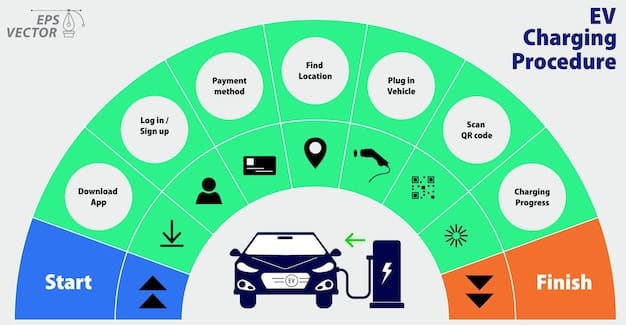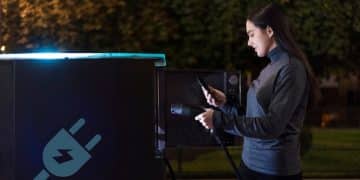New EV Tax Credit: 2025 Buyer’s Guide to Federal Incentives

The New Federal Tax Credit Expansion, as part of the Inflation Reduction Act, significantly impacts electric vehicle (EV) buyers in 2025 by offering updated incentives, altered eligibility criteria, and new requirements for battery sourcing and vehicle assembly in North America, aiming to make EVs more affordable.
The landscape of electric vehicle (EV) ownership is constantly evolving, and the New Federal Tax Credit Expansion: How the Updated Electric Vehicle Incentive Program Impacts 2025 Buyers is a significant piece of that puzzle. Navigating the complexities of federal tax credits can be daunting, but understanding the changes can save you thousands of dollars on your next EV purchase.
Understanding the Inflation Reduction Act and EV Tax Credits
The Inflation Reduction Act (IRA) introduced significant changes to the federal EV tax credit, aiming to boost domestic manufacturing and accelerate the transition to electric vehicles. This legislation reshapes the incentives available to consumers looking to purchase EVs in 2025.
Several key provisions within the IRA directly affect the EV tax credit. These include changes to the credit amount, income limitations for eligibility, and new requirements related to battery sourcing and final assembly location. Understanding these provisions is crucial for potential EV buyers.
Key Provisions of the Inflation Reduction Act Affecting EV Tax Credits
The IRA outlines several key changes to the EV tax credit, including increasing the maximum credit amount and extending the availability of the credit to used EVs. Additionally, the Act introduces income limitations and sourcing requirements that significantly impact eligibility.
- Increased Credit Amount: Eligible new EVs can qualify for a tax credit of up to $7,500, making EV ownership more affordable.
- Used EV Credit: The IRA introduces a tax credit for used EVs, further expanding access to electric transportation options.
- Income Limitations: Modified adjusted gross income (MAGI) limits are in place to ensure the credit benefits those who need it most.
- Sourcing Requirements: Vehicles must meet specific requirements related to battery components and critical mineral sourcing to qualify for the full credit.
It’s important for consumers to stay up-to-date on these changes to maximize potential savings and navigate the complexities of the EV tax credit program effectively.

Eligibility Requirements for the 2025 EV Tax Credit
To qualify for the federal EV tax credit in 2025, buyers must meet certain eligibility requirements related to income, vehicle price, and the vehicle’s origin. Understanding these criteria is essential to determining whether you can claim the credit.
The income limits, vehicle price caps, and manufacturing requirements play a significant role in determining eligibility. Buyers must ensure they meet all criteria to claim the full credit amount.
Income Limits and Filing Status
The IRA introduces income limitations based on the buyer’s modified adjusted gross income (MAGI). These limits vary based on filing status, ensuring the credit is targeted towards those with lower incomes.
- Single Filers: The MAGI limit for single filers is $150,000.
- Head of Household: Those filing as head of household have a MAGI limit of $225,000.
- Married Filing Jointly: For married couples filing jointly, the MAGI limit is $300,000.
Buyers with incomes exceeding these limits are not eligible for the EV tax credit. It’s crucial to calculate your MAGI accurately to determine your eligibility.
Vehicle Price Caps and Eligible Models
The IRA also sets price caps on eligible EVs, ensuring the credit is focused on more affordable models. The price limits vary based on the type of vehicle.
- Vans, SUVs, and Trucks: New vehicles cannot exceed $80,000.
- Cars: New vehicles cannot exceed $55,000.
Checking the manufacturer’s suggested retail price (MSRP) of the EV before purchasing is essential to ensure it falls within these limits.
Manufacturing and Sourcing Requirements
One of the most significant changes introduced by the IRA is the requirement for EVs to be assembled in North America to qualify for the tax credit. Furthermore, the battery components and critical minerals must meet specific sourcing requirements.

How Battery Sourcing Impacts the Tax Credit
The IRA’s battery sourcing requirements are designed to incentivize domestic manufacturing and reduce reliance on foreign supply chains. These requirements significantly impact the amount of tax credit an EV can qualify for.
EVs must meet specific criteria related to the origin of battery components and critical minerals to receive the full tax credit. Failure to meet these requirements can result in a reduced credit amount or ineligibility altogether.
Critical Mineral Requirements
To qualify for the full tax credit, a certain percentage of the critical minerals in the EV’s battery must be extracted or processed in the United States or countries with a free trade agreement with the U.S.
- The percentage requirement increases over time, encouraging manufacturers to diversify their supply chains.
- Critical minerals include lithium, cobalt, nickel, and manganese.
- Meeting these requirements can be challenging, as many critical minerals are currently sourced from countries outside the U.S. and its free trade partners.
Manufacturers are working to adapt their supply chains to meet these requirements, but it may take time for the full impact to be realized.
Battery Component Requirements
In addition to critical mineral sourcing, a certain percentage of the EV’s battery components must be manufactured or assembled in North America to qualify for the full tax credit.
- The percentage requirement increases annually, creating a growing incentive for domestic battery manufacturing.
- Battery components include cells, modules, and packs.
- This requirement is designed to promote job growth and investment in the U.S. battery industry.
Vehicles that meet both the critical mineral and battery component requirements are eligible for the full $7,500 tax credit.
Navigating the IRS Clean Vehicle Credit Website
The IRS Clean Vehicle Credit website is a valuable resource for EV buyers seeking information about the federal tax credit. This website provides guidance on eligibility requirements, eligible vehicle models, and how to claim the credit on your tax return.
Navigating the website effectively can help you determine your eligibility and maximize your potential savings. Familiarize yourself with the available resources and updates to stay informed.
Finding Eligible Vehicle Models
The IRS website features a tool to help you identify eligible vehicle models that meet the requirements for the tax credit. This tool allows you to search by make, model, and year to determine eligibility.
- The list of eligible vehicles is updated regularly as manufacturers certify compliance with the sourcing requirements.
- You can filter the search results by vehicle type, such as car, truck, SUV, or van.
- The tool also provides information on the amount of tax credit available for each vehicle model.
Checking this list before purchasing an EV is essential to ensure it qualifies for the tax credit.
Understanding the Credit Amount and Claim Process
The IRS website provides detailed information on how the tax credit amount is calculated and how to claim the credit on your tax return. This information includes instructions on completing the necessary tax forms and documentation.
- You will need to file Form 8936, Clean Vehicle Credits, with your tax return to claim the credit.
- Keep records of your vehicle purchase, including the date of purchase, vehicle identification number (VIN), and price.
- The credit is nonrefundable, meaning it can only reduce your tax liability to $0.
Following the instructions on the IRS website carefully can help you avoid errors and ensure you receive the correct tax credit amount.
The Impact on 2025 EV Buyers
The changes to the federal EV tax credit will have a significant impact on EV buyers in 2025. Understanding these changes is essential to making informed purchasing decisions and maximizing potential savings.
The eligibility requirements, sourcing rules, and credit amounts will influence which EVs are most attractive to buyers and how much they can save on their purchase. Careful planning and research are essential.
Adjusting Purchasing Decisions to Maximize Savings
EV buyers may need to adjust their purchasing decisions to maximize potential savings under the new tax credit rules. This includes considering vehicle price, origin, and compliance with sourcing requirements.
Consider these factors when making your purchase decision:
- Vehicle Price: Choose an EV that falls within the price cap for its vehicle type.
- Assembly Location: Confirm that the vehicle undergoes final assembly in North America.
- Sourcing Compliance: Look for vehicles that meet the critical mineral and battery component sourcing requirements.
By carefully considering these factors, you can increase your chances of qualifying for the full tax credit.
Looking Ahead: Future Changes to the EV Tax Credit
The federal EV tax credit is subject to further changes in the coming years as the sourcing requirements become more stringent. Staying informed about these changes is essential for future EV buyers.
- The percentage requirements for critical mineral and battery component sourcing will continue to increase annually.
- New regulations and guidance may be issued by the IRS.
- Manufacturers will continue to adapt their supply chains to meet the evolving requirements.
Keep an eye on updates from the IRS and industry experts to stay informed about the latest developments in the EV tax credit program.
Future Trends in the Electric Vehicle Market
The electric vehicle market is expected to continue growing rapidly in the coming years. This growth will be driven by factors such as increasing consumer demand, technological advancements, and government incentives.
Several key trends are shaping the future of the EV market, including increased battery range, faster charging times, and lower prices. These trends will make EVs more attractive to a wider range of consumers.
Advancements in Battery Technology
Ongoing advancements in battery technology are leading to increased energy density, longer range, and faster charging times. These improvements are addressing some of the key concerns of potential EV buyers.
- Solid-state batteries are expected to offer significant improvements in energy density and safety.
- New battery chemistries are being developed to reduce reliance on scarce and expensive materials.
- Wireless charging technology is becoming more widely available.
These advancements will make EVs more competitive with traditional gasoline-powered vehicles.
Expanding Charging Infrastructure
The expansion of charging infrastructure is crucial to supporting the growth of the EV market. Governments and private companies are investing in new charging stations across the country.
- Fast charging stations are becoming more common, allowing drivers to quickly replenish their batteries on the go.
- Public charging networks are expanding their coverage to more rural areas.
- Home charging solutions are becoming more affordable and accessible.
A robust and reliable charging infrastructure will make EV ownership more convenient and practical.
| Key Point | Brief Description |
|---|---|
| 💰 Credit Amount | Up to $7,500 for new EVs, based on meeting requirements. |
| 📍 Assembly Location | Vehicle must undergo final assembly in North America. |
| 🔋 Battery Sourcing | Specific percentages of battery components/minerals must be from the U.S. or free trade partners. |
| 💲 Income Limits | MAGI limits apply: $150k (single), $225k (HOH), $300k (married filing jointly). |
Frequently Asked Questions (FAQ)
▼
The maximum tax credit for a new EV is $7,500, but this depends on meeting specific sourcing and assembly requirements outlined in the Inflation Reduction Act.
▼
The income limits are based on your modified adjusted gross income (MAGI) and filing status: $150,000 for single filers, $225,000 for head of household, and $300,000 for married couples filing jointly.
▼
Yes, the EV must undergo final assembly in North America to be eligible for the federal tax credit. You can check the assembly location using the vehicle’s VIN.
▼
To receive the full tax credit, a certain percentage of the critical minerals and battery components must be sourced from the U.S. or countries with a free trade agreement with the U.S.
▼
The IRS Clean Vehicle Credit website provides a tool to search for eligible EV models based on make, model, and year. The list is updated regularly as manufacturers certify compliance.
Conclusion
Navigating the New Federal Tax Credit Expansion: How the Updated Electric Vehicle Incentive Program Impacts 2025 Buyers requires a thorough understanding of the Inflation Reduction Act’s provisions. By staying informed about eligibility requirements, sourcing rules, and future trends in the EV market, buyers can make informed decisions and maximize their potential savings while contributing to a more sustainable future.





